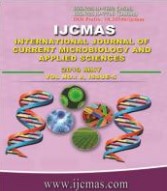


 National Academy of Agricultural Sciences (NAAS)
National Academy of Agricultural Sciences (NAAS)

|
PRINT ISSN : 2319-7692
Online ISSN : 2319-7706 Issues : 12 per year Publisher : Excellent Publishers Email : editorijcmas@gmail.com / submit@ijcmas.com Editor-in-chief: Dr.M.Prakash Index Copernicus ICV 2018: 95.39 NAAS RATING 2020: 5.38 |
Neonatal sepsis is a significant cause of morbidity and mortality in newborns and is responsible for 30 – 50 % of total neonatal deaths. Multidrug resistant Gram negative bacilli belonging to the family Enterobcteriaceae have been increasingly responsible for infections among the neonates admitted to the NICU in many countries including India. The study was conducted to know prevalence of ESBL production in Klebsiella pneumoniae and Escherichia coli in NICU so that we can help clinicians to avoid injudicious use of antibiotics. The present study was carried out from July 2017 to December 2018 in Microbiology Department of the rural medical college in North Maharashtra. A total of 200 samples of blood cultures from neonates admitted in the NICU were processed for the study. 2 ml blood from the neonates was collected under aseptic precautions and the samples were inoculated on blood culture bottle containing Brain Heart Infusion (BHI) broth. Gram negative isolates recovered from septicemic cases were further tested for presence of ESBL and resistance pattern. Blood culture is positive in 134 (67%) among 200 suspected cases of neonatal septicemia. Gram negative isolates are seen in 94 (70.15%) cases whereas Gram positive isolates are seen in 35 (26.11%) cases. The common organism isolated are Klebsiella pneumoniae 53 (39.55%) followed by Escherichia coli 27 (20.15%) and Staphylococcus aureus 25 (18.66%) (Table 1). The ESBL production is more seen in Klebsiella 29 / 53 (54071%) and Escherichia coli 12/27 (44.44%). Multidrug resistance is seen in most of the ESBL producing strains which was higher than that seen in no ESBL producing strains. Bacteriological profile of neonatal septicemia varies in different regions of the country like India. Empirical therapy in NICU should be regularly monitored according to the prevalence of ESBL producing organisms in tertiary care centers.
 |
 |
 |
 |
 |